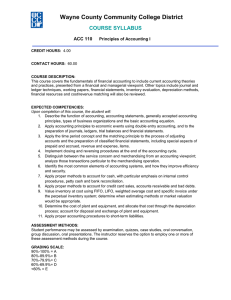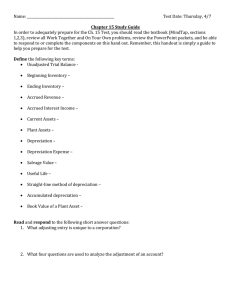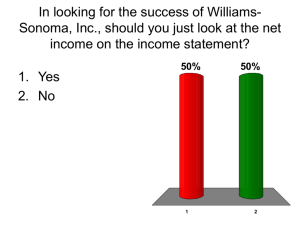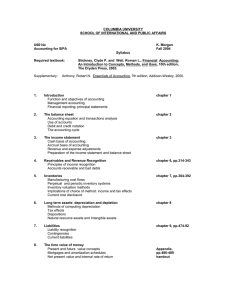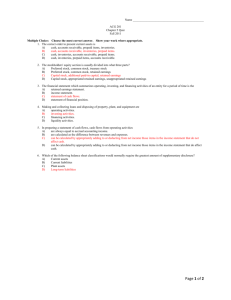Preparing a Statement of Cash Flows: Indirect Method
advertisement
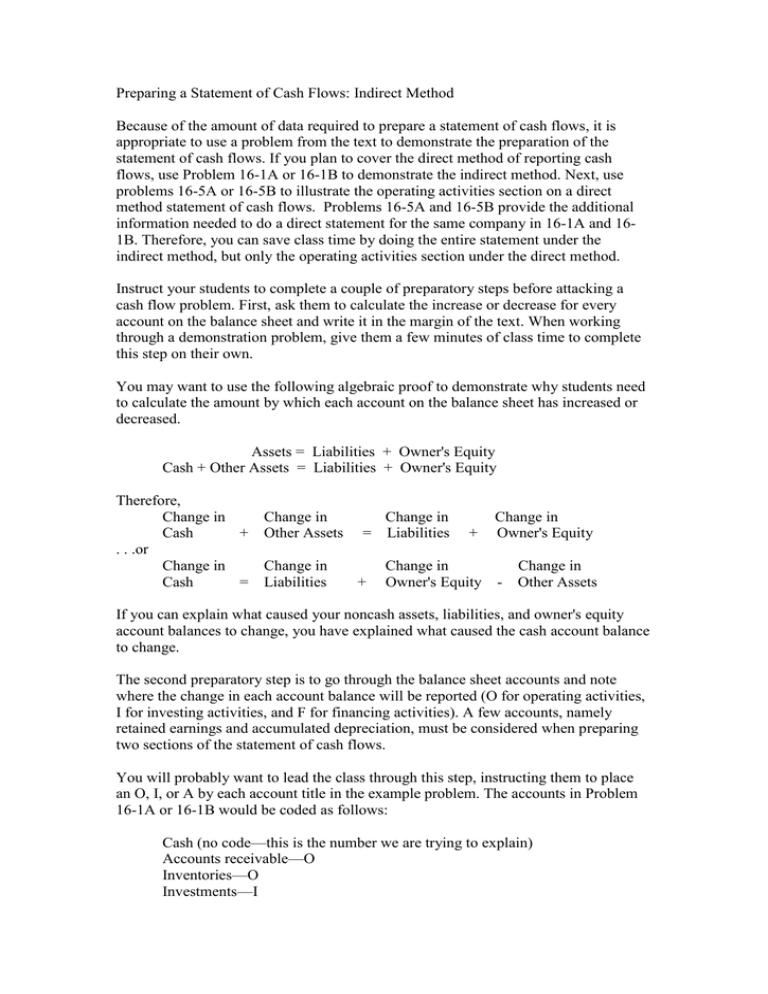
Preparing a Statement of Cash Flows: Indirect Method Because of the amount of data required to prepare a statement of cash flows, it is appropriate to use a problem from the text to demonstrate the preparation of the statement of cash flows. If you plan to cover the direct method of reporting cash flows, use Problem 16-1A or 16-1B to demonstrate the indirect method. Next, use problems 16-5A or 16-5B to illustrate the operating activities section on a direct method statement of cash flows. Problems 16-5A and 16-5B provide the additional information needed to do a direct statement for the same company in 16-1A and 161B. Therefore, you can save class time by doing the entire statement under the indirect method, but only the operating activities section under the direct method. Instruct your students to complete a couple of preparatory steps before attacking a cash flow problem. First, ask them to calculate the increase or decrease for every account on the balance sheet and write it in the margin of the text. When working through a demonstration problem, give them a few minutes of class time to complete this step on their own. You may want to use the following algebraic proof to demonstrate why students need to calculate the amount by which each account on the balance sheet has increased or decreased. Assets = Liabilities + Owner's Equity Cash + Other Assets = Liabilities + Owner's Equity Therefore, Change in Change in Change in Change in Cash + Other Assets = Liabilities + Owner's Equity . . .or Change in Change in Change in Change in Cash = Liabilities + Owner's Equity - Other Assets If you can explain what caused your noncash assets, liabilities, and owner's equity account balances to change, you have explained what caused the cash account balance to change. The second preparatory step is to go through the balance sheet accounts and note where the change in each account balance will be reported (O for operating activities, I for investing activities, and F for financing activities). A few accounts, namely retained earnings and accumulated depreciation, must be considered when preparing two sections of the statement of cash flows. You will probably want to lead the class through this step, instructing them to place an O, I, or A by each account title in the example problem. The accounts in Problem 16-1A or 16-1B would be coded as follows: Cash (no code—this is the number we are trying to explain) Accounts receivable—O Inventories—O Investments—I Land—I Equipment—I Accumulated Depreciation—O and I Accounts Payable—O Accrued Expenses—O Dividends Payable— F Common Stock—F Paid-in Capital—F Retained Earnings—O and F Now your students are ready to attack the problem, beginning with the operating activities section. Students should be encouraged to use a "check-off" method in completing the statement of cash flows. The basics of the check-off method are as follows: when the total change in an account has been explained, check it off. Once an account has been checked off, you don't need to look at it again. For example, the first step in the operating activities section is to show the amount of net income. This information is obtained from the income statement or, in accounting class, from the "additional information" accompanying the problem. Net income is closed to the retained earnings account; however, in Problem 16-1A, retained earnings increased by $124,600, even though net income was $180,600. Some other transaction must be affecting the account. Because the change in the account balance has not been fully explained, the account cannot be checked off. As the coding system shows, students must look at retained earnings again when preparing the financing activities section. The next step in the operating activities section is to add back any depreciation, amortization, or depletion. What account on the balance sheet would contain the depreciation for the year? Answer: Accumulated Depreciation. However, that account is also affected by entries to remove fixed assets when sold or discarded. In Problem 16-1A, we are told that there were no disposals of equipment. Therefore, the only entry in the accumulated depreciation account would be the adjusting entry for the year's depreciation expense. The $26,000 change in this account is the depreciation expense to be added to net income. Because the change in the account balance has been fully explained, the accumulated depreciation account can be checked off. Those are the basic steps in the check-off method. At this time, instruct your students to review the additional information given with the problem to look for any gains and losses on investing and financing activities. Remind them that gains and losses occur only when assets are sold and liabilities settled. Problem 16-1A has a $12,000 gain on the sale of investments that must be deducted from net income. Ask your students to answer the following questions. (1) If there had been a loss of $20,000 on the sale of investments, how would this be reported on the operating activities section of the statement of cash flows? Answer: the loss would be added to net income. (2) If fully depreciated equipment had been sold for $2,000, how would this be reported on the operating activities section of the statement of cash flows? Answer: The $2,000 gain would be deducted from net income. Now it is time to look at the current assets and current liabilities related to operations. Instruct your students to go through the accounts coded with O's and write down whether each account increased or decreased, and by what amount. Then, ask your students to determine whether the change had a positive or negative effect on cash. Many students want to cling to text Exhibit 4 to assist with this task, so try to give them a logical approach to determine how account changes affect cash. The suggested explanations are overly simplified and, therefore, not “totally” accurate. However, most of your students will find them useful. For example, accounts receivable in Problems 16-1A and 16-1B increased. A simplified explanation of how this effects cash flows: If accounts receivable went up, did you sell more or less on credit? More. If you sold more on credit, did you sell more or less for cash? Less. If you sold less on cash, what was the effect on the cash account? It decreased. Therefore, the change in accounts receivable is subtracted. Now, in reality, accounts receivable may have increased because customers are paying more slowly. Accounts receivable also may have increased simply because total sales increased without a corresponding increase in cash sales. When insightful students bring up these arguments, agree with them. Point out that the original explanation is useful because it is simple and tends to make sense to most students. When accounts receivable decrease, your explanation is the inverse: The company sold less on credit, so it sold more for cash and the cash account is increased. Explanations for changes in other accounts follow. Increase in Inventory: The company bought more inventory, so it has to pay for more inventory. Cash is decreased. Decrease in Inventory: The company bought less inventory, so it doesn't have to pay for as much inventory. Cash is increased. Increase in Prepaid Expense: The company has prepaid more expenses, using its cash. Cash is decreased. Decrease in Prepaid Expense: The company has prepaid fewer expenses, saving its cash. Cash is increased. Increase in Accounts Payable: The company has bought more on credit, so it has bought less with cash. Cash is increased. Decrease in Accounts Payable: The company has bought less on credit, so it is buying more with cash. Cash is decreased. Once all accounts marked O have been checked off, it is time to move on to the investing and financing accounts. Work through these accounts one by one, using the additional information to determine what caused the accounts to change. List the transactions and amounts on the statement of cash flows, checking accounts off as the change in their balances are explained.



